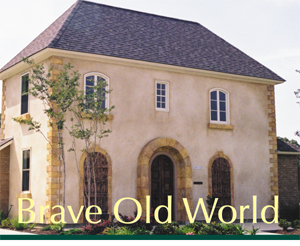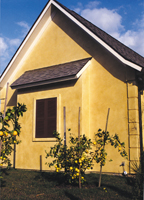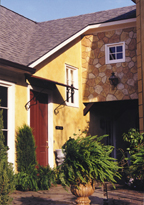

"We traced our family tree and went to Sicily in 1995," says Frank. "We're full-blooded Italian. We were inspired by our visits to Italy and Sicily, and we wanted to recreate the charm of those areas."
Influenced by their trips to Europe--and in particular the villas found in Rome, Florence, Sicily and other regions of Europe--the Bellipanni's Old World Villas subdivision is Frank and Vince's love letter to their heritage, country and God. Each home is christened with a name and has historical or geographical significance. Villa Lucca and Villa Siena borrow their names from a town in the Tuscan Valley. La Lubron is the setting for Shakespeare's "Romeo and Juliet."
The idea that each home is flavored with its own cultural context should be appealing to homebuyers and add a greater mix to the market. Undoubtedly motivated to contribute a bit of themselves, it is the Bellipanni's hopes that America shows a re-interest in foreign architecture and culture, as the two tend to complement one another in Europe. Whether America as a whole welcomes homes that reflect a European style is yet to be determined, however, area residents in Baton Rouge are lining up to live in the Old World.
"These (homes) would not be the norm--Acadain is the popular-style home in the area," explains Vince. "You'll find a mix of French or the New Orleanian-style (Spanish-French)."
Educated as accountants, the brothers found the financial world constraining, so instead took to chasing careers in design and development. Holding firmly to their vision, the brothers began work on the subdivision in May 1999.
"We wrote out the checks and contracted out the work for the neighborhood," says Frank. Among the characters the Bellipanni's recruited was Oliver Aucoin, president of Aucoin Plastering, Baton Rouge, to complete the finish look that would distinguish the Old World Villa from its neighboring homes.

That's Italian
The brothers wanted to bring what they saw across the Atlantic to their own backyard. The architecture was easy enough to interpret, but the Italian homes have a distinctive exterior finish which is harder to translate. This meant employing different types of veneer systems to create an exterior look that would resemble what they saw on the Mediterranean-flavored homes. Surprisingly, straight applications of stucco didn't produce the veneer the brothers were looking to achieve. Nor did straight EIFS. No, it took every amount of ambition to match the science for that classic Italian-style look that is found in the subdivision.The brothers experimented intensely to find the look they wanted. That "look" wasn't achieved by applying straight EIFS or straight stucco to the walls, but combining those to create a veneer unlike any other on the block. The exterior finish is a hybrid of Omega's Akrotique and real stucco.
Straight stucco was believed to produce the look of the Old World. Realizing the finish could be made more dramatic and rustic, the Bellapannis used the Omega product to show passersby the classical features of foreign architecture.
The Old World subdivision is ornate with arched doorways, crosswalks, cornerstones, decorative ornamental moldings on the exterior walls, windows the size of doors, etc.--many of which have stone embedded in the feature.
Well, it looks like stone.
"We're using the Omega product to help us get the age-old look," says Franco. "We had to go through several systems to see what was in our image of the look we wanted. We combine colors, we dilute colors down, we're working on a three-dimensional art project. It has the same look and feel as cement, but it is an acrylic product. A synthetic finish."
For the stucco work done on all the homes of the Old World Villas, Aucoin lists the recipe and the process of creating the rustic veneer.
"We applied the metal lath," he explains, "and then we scratch-coated the walls. One bag of Portland cement; 1 bag of masonry mortar mix; 25 shells of sand; and applied it over the metal lath with hawk and trowel for the basecoat.
"This (the basecoat) sits for one day" says Aucoin, "we come back, make the same material, but this time add 40 shovels of sand, which was the browncoat. We applied this 3/4-inch thick and we rod it off--got it leveled. Then put one more application on--the finish application--which is the Omega stuff."
When asked what was done to prepare the Omega ingredient, Aucoin simply remarks, "The Omega stuff comes all prepared."
Villa Siena, the second home constructed in the subdivision, uses the finish coat in multiple ways. The standard finish coat (the walls alone) over the entire house uses the Bellipanni mix of the Akrotique applied over the stucco. However, the ornate work features a European alleyway, above a cobblestone crosswalk, that shows that imagination was a strong virtue on the project. The brothers had a concept to duplicate all the stone bridges found abroad and use that look for decorative accents surrounding the more conventional finish. The irony is the stone isn't stone, but their concoction of the Omega product and stucco.
"It was our attempt to create the crosswalks of Siena, in Tuscany, outside of Florence," says Vince. "The stone on the side of the crosswalk is stucco. We're freehand cutting the stones; we come back and built those up with the Akrotique sand based-finish. Everything is cut by hand with a simple homemade tool."

Bellissimo
To add even greater depth to these stones, and to achieve a greater sandstone look, the brothers layered textures by flinging material against the dried faux stone. "We call it the 'dash,'" adds Franco. "We take wet stucco, and hand shape the stone. Then to give it more three-dimensional space, we fling it onto the stucco after a day's worth of drying. That is the Omega product: We're just letting this drip on to the faux stone and how it drops, it dries, and that's how it is."For all intents and purposes, the Omega product operates on different levels and is clearly a product designed for the creative.
"The system is a stain over a white-based stucco system" says Omega's Darren Whiting, sales and co-owner. "It is absorbed by the stucco to give it color and also creates a water-resistant coating."
"I have found recently," says Whiting, "that homeowners want to distinguish themselves from other homes in development. This product gives the owner/builder a color alternative besides the usual clean, consistent tinted stucco look."
In the spirit of creating, though using different application methods, the Omega product can be found used on most of the exterior ornamentation throughout the subdivision.
The Bellipanni brothers are now into their eighth home. Considering only four homes can be built per year, and that the Old World Villas has 23 lots they need to fill, the next few years' time will be anything but idle. The brothers currently live in Villa Siena, and have sold Villa Lucca, La Luberon, Villa Verona, Villa Amalfi, and the list continues. Each home will be unique in floor plan and material used, with each decorative touch accenting a European drawl and hybrid veneer system.
"Our slogan is 'We call it art, you call it home,'" says Frank. "We feel each home is art--functional art--in which people live. We feel our desire to design and create is in our blood passed down from generations of Italians before us."
The Bellipanni brothers' are modest in their careers. They feel they've just consumed all the finer points of Italian and European homes and transcribed this into their projects Stateside. As the Old World subdivision develops and prospers, Vince and Frank make it a necessity to deliver thanks.
"We ... give credit to our grandparents who came to America from Cefalu, Sicily," says Frank, "in search of a better life, and to God for giving us the talents to accomplish what we do. We are merely making the most of the opportunity they have provided us."


Report Abusive Comment